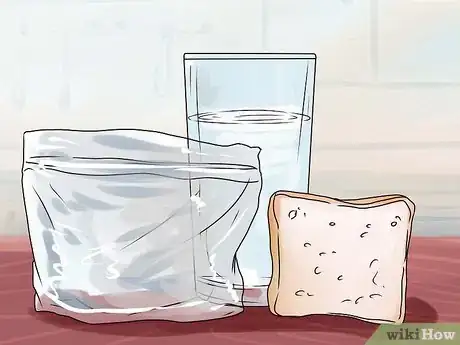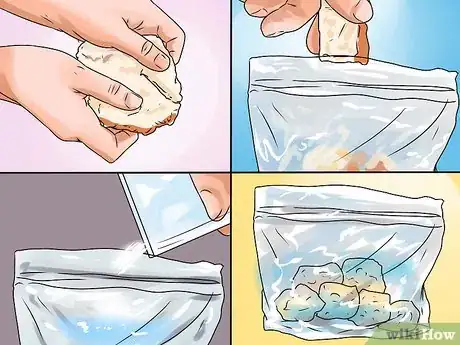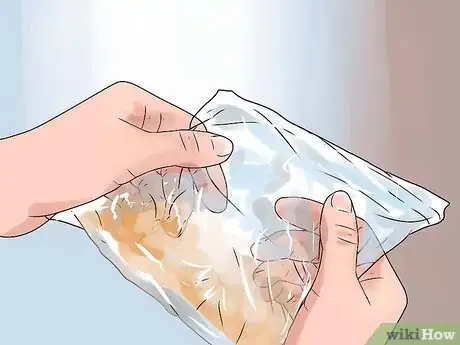This article was co-authored by Bess Ruff, MA. Bess Ruff is a Geography PhD student at Florida State University. She received her MA in Environmental Science and Management from the University of California, Santa Barbara in 2016. She has conducted survey work for marine spatial planning projects in the Caribbean and provided research support as a graduate fellow for the Sustainable Fisheries Group.
There are 9 references cited in this article, which can be found at the bottom of the page.
wikiHow marks an article as reader-approved once it receives enough positive feedback. In this case, several readers have written to tell us that this article was helpful to them, earning it our reader-approved status.
This article has been viewed 132,872 times.
If you're doing an experiment in your home, it's best to stick with common kitchen ingredients to simulate stomach acid. You probably already have items at home you can use. Additionally, you can simulate the stomach using a plastic zip-top bag, to further your experiment.
Steps
Simulating Stomach Acid With Kitchen Ingredients
-
1Use a cup of plain, white vinegar. While vinegar is not as acidic as stomach acid, it can be used to simulate what a stomach does in a simple experiment. To use it, simply fill a cup with vinegar, and drop what you want to test into the cup.[1]
- Make sure the cup has enough vinegar in it to cover the object.
- The pH scale goes from 0 (extremely acidic) to 15 (extremely basic). Water is neutral at 7.[2] The acidity of stomach acid is usually in the range of 1 to 3 on the pH scale.[3] It can decrease in acidity as food enters the stomach. Similarly, vinegar has a pH of about 2.8.
-
2Try lemon juice. Like vinegar, lemon juice can be used to simulate stomach acid. Bottled lemon juice tends to be more stable in its pH than fresh squeezed, though you can use either. Lemon juice is at about a 2 on the pH scale.[4]
- Lime juice is on par with lemon juice, at about 2 on the pH scale.
Advertisement -
3Use orange juice. Orange juice isn't quite as acidic as lemon juice. It's about a 3 on the pH scale. However, it will do in a pinch, as it is still acidic.[5]
- Grapefruit juice is on a similar level to orange juice and can also be used; the canned version is slightly more acidic.
-
4Drop food or substances into your simulated stomach acid. You might drop 1 uncoated and 1 coated aspirin into the cup. Note that the uncoated aspirin will dissolve, while the coated aspirin will not.[6] Another option is to try pieces of food, such as bread or cereal. Since the amount of time it takes to break down food can vary, set a time and observe the breakdown process. Stop the timer when the food breaks down.
- Take notes about the process, such as how long it takes, what you observe, and the conditions of the experiment, such as the room temperature and how much acid you used.[7]
Simulating the Stomach Physically
-
1Gather your materials. For this type of experiment, you can simulate a stomach with a strong zip-top plastic bags. Freezer bags are usually stronger than regular bags. You'll also need water (or one of the liquids from the first section) and food (bread works well).[8]
- While using water doesn't simulate stomach acid, most foods will break up in water eventually, especially bread or crackers.
- You also may want to wear latex gloves for this experiment, as well as put down newspaper or paper towels.
-
2Combine the ingredients. Tear the food into larger pieces to simulate the teeth breaking it apart. Add the food to the bag. Pour in enough liquid to cover the bread. Squeeze out the extra air, and zip up the bag.[9]
-
3Make the stomach action. Gently squeeze the bag back and forth. This motion simulates how the stomach works. Keep working at it until the food is mostly broken apart.[10]
-
4Decide if you want to continue the experiment. At this point, you can end the experiment, as you've simulated the stomach. However, you can also simulate the small intestine. For this part of the experiment, you'll need a single stocking, with the foot cut out. Scoop the food in one end. Squeeze the food down the stocking, noticing how liquid comes out through the stocking as you go. When you've reached the other end, squeeze the food out onto a plate, simulating how food is turned into feces and squeezed out of the anus.[11]
Community Q&A
-
QuestionIs lemon juice or vinegar stronger?
 Community AnswerVinegar is slightly more acidic than lemon juice, because lemon juice is on average five to six percent citric acid. Vinegar on the other hand is comprised of acetic acid.
Community AnswerVinegar is slightly more acidic than lemon juice, because lemon juice is on average five to six percent citric acid. Vinegar on the other hand is comprised of acetic acid. -
QuestionIs this project safe?
 Community AnswerYes, it is.
Community AnswerYes, it is. -
QuestionIs the any way I can simulate the actual stomach besides using a plastic bag?
 Community AnswerYou could use a balloon as well. But if you want to see the "acid" in action, then a plastic bag would be a better choice, since clear balloons are difficult to find.
Community AnswerYou could use a balloon as well. But if you want to see the "acid" in action, then a plastic bag would be a better choice, since clear balloons are difficult to find.
Warnings
- Stomach acid is actually hydrochloric acid (also called muriatic acid), which you can buy at the hardware store. However, that acid is highly concentrated, and you should not work with it in your home as it can be explosive and burn through things, including your skin.[12]⧼thumbs_response⧽
References
- ↑ https://www.teachengineering.org/view_lesson.php?url=collection/cub_/lessons/cub_biomed/cub_biomed_lesson05.xml
- ↑ http://www.sciencebuddies.org/science-fair-projects/project_ideas/Chem_AcidsBasespHScale.shtml
- ↑ https://www.ucsfhealth.org/medical-tests/stomach-acid-test
- ↑ http://www.sciencebuddies.org/science-fair-projects/project_ideas/Chem_AcidsBasespHScale.shtml
- ↑ http://www.sciencebuddies.org/science-fair-projects/project_ideas/Chem_AcidsBasespHScale.shtml
- ↑ https://www.teachengineering.org/lessons/view/cub_biomed_lesson05
- ↑ https://www.csub.edu/chemistry/_files/Simulated%20Stomach%20AcidAOdocx.pdf
- ↑ https://www.howtosmile.org/resource/ziploc-digestion-simulator
- ↑ https://www.howtosmile.org/resource/ziploc-digestion-simulator


































































